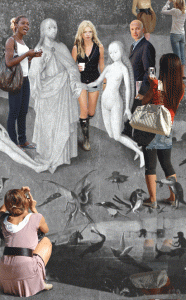« Features
PUSH TO FLUSH / The Wine Paradigm (Or, what’s curating got to do with it…)
Many people in the wine industry claim wine is an art, not a science. I guess there must be something really ‘arty’ to it, as in every gallery and museum-be it private or public, and regardless of their nationality-openings are accompanied in an almost exclusive and quasi-liturgical manner by this sophisticated drink. Yet wine was originally a peasant’s beverage that was served with common meals, and it was not until the Middle Ages that the nobility raised viticulture to a sign of class.
In the Old World, many countries claim there is too much wine; in the New World, many claim that there is not enough. Both have very different-and even maybe honest-ideas about winemaking practice. Now, at stake is a small figure of around $250 billion by end of 2010!
The wine business has changed, suggests Professor Christopher A. Bartlett in his exciting Harvard Business School case “Global Wine Wars: New World Challenges Old,” published in 2003.1 This change has provided chances for countries like the United States, Australia, and, say, Chile, who have introduced daring innovations. Old countries like France, Italy, and Spain have maintained their restrictive traditions and practices. I came across this article a year ago through a friend who knew about my interest in wine. Since then, I have not stopped thinking how curating too has changed, and to what extent global markets and new contexts have provided similar opportunities. Especially in times of crisis like these, when many museums are forced by budgetary cutbacks and declining sponsorships to return to the more pristine and traditional ‘caretaking’ and ‘showcasing’ of their permanent collections. Just look around you…
CHANGE OF PARADIGM
Coming from the Greek word ‘paradeigma,’ paradigm has been defined as a ‘pattern or model, an example,’ and in many cases refers to a context that is ‘expansive’ and ‘dynamic.’ Therefore, from time to time we have to deal with (social) circumstances that precipitate a shift of paradigm.
Now, think of winemaking. Traditionally vineyards have been very small in Europe, and tending and harvesting grapes very labor intensive. Wine, according to Bartlett, was sold in bulk to merchant traders-négociants-and only the rich could afford the imported luxury, due to complex toll and tax systems. Later in the nineteenth century, innovations like mass production, glass bottles, and the cork stopper expanded production. With the industry’s growing importance, governments used classification schemes like the Appellation d’Origin Controllée. The French especially nurtured the concept of terroir: a perfect combination of soil, aspect, microclimate, rainfall, and cultivation that provides the unique taste of each wine and region. But ‘terroir,’ like curating, cannot always guarantee quality as wine is always subject to weather and disease (remember how phylloxera, a deadly New World insect, almost devastated French vine stock in the last quarter of the nineteenth century).

Lluis Barba, The Garden of Earthly Delights. Bosco (detail) from the series "Tourists in Art", 2007, Diasec, 212.5"x118". Courtesy Galeria Sicart, Vilafranca del Penedes.
What did the New World do after decades of being ridiculed by traditional wine countries? Even though immigrants started winemaking during the eighteenth century, its size and reputation were insignificant until the twentieth century postwar era, when the demand for wine increased dramatically in the United States, Australia, New Zealand, and South Africa. This strong domestic demand established the young wine industry in these New World countries. The New World producers experimented with new technology, such as drip irrigation, reverse osmosis technology, computer-controlled stainless steel tanks, as well as the addition of oak chips, the use of fertilizers, and pruning methods (most of which were forbidden in the Old World) that produced consistent wine year to year. Finally, New World also innovated packaging (wine-in-a-box, screw caps), marketing, and distribution, and especially challenged the traditional ‘appellation names’ system by labeling their wines with the grape variety: cabernet sauvignon, merlot, chardonnay, etcetera.
NEW PLATFORMS
Unconstrained in the same manner by size or tradition, curatorial practices have also opened new markets, challenged production norms, and reinvented the marketing model.
Globalization, the World Wide Web, new technologies, and low-cost travel have brought new countries and continents like India, China, Russia, Asia, and the Middle East to the contemporary art market since the late 1990s. But even more so, they have challenged the traditional platform of excellence-the museum-by introducing new curatorial platforms: art fairs, books, hotels, websites, and public space.
What about art fairs? Most of them have their special curated projects-think of Frieze and Frieze Projects-with more or less success. Furthermore, since the publication of CREAM by Phaidon in 1998, and Art at the Turn of the Millenium by TASCHEN in 1999, many other books have appeared on a biennial basis that de facto act as a big exhibition platform for established (and sometimes emerging) international artists. On top of that, French curator Jérôme Sans worked as ‘hotel’ curator for Le Méridien, organizing exhibits, projects, and parties on hotel premises, and many biennials and international contests like Madrid Abierto address public space as an extended venue for curatorial endeavors. Even the Web itself provides new curatorial opportunities.
On the other hand, curatorial practices centered on conservation and acquisition of a permanent collection shifted toward a thematic or monographic exhibitions policy, especially the ‘blockbuster’ model, in search of media coverage and increasing visitor numbers.
Now the real question for a museum is if in order to cater less sophisticated palates their drive for efficiency and consistency on one hand, and the media and visitor needs on the other, has made it lose the character and unpredictable differences that came with the traditional ‘vintage’ way?
I wonder why most wines served at openings-pardon me-suck. If I were you, I’d look at the label next time… As for me, I declare myself a traditionalist: I’d rather stick to the unpredictable French, Italian or Spanish wines and their ‘terroir’!
NOTES
1 See, Bartlet, Christopher A. Global Wine Wars. New World Challenges Old. (9-303-056) Cambridge: Harvard Business School. July 21, 2003.



































